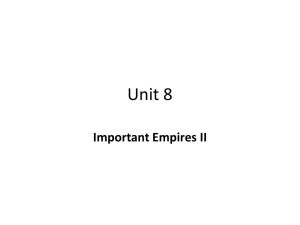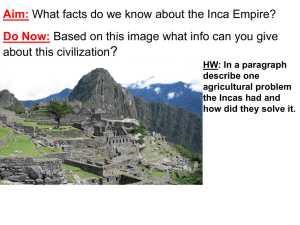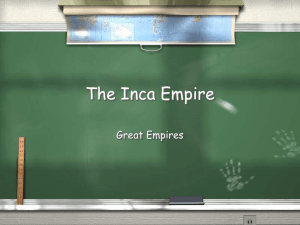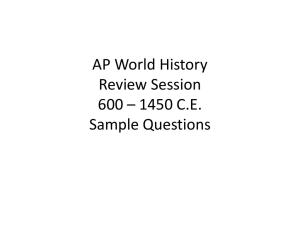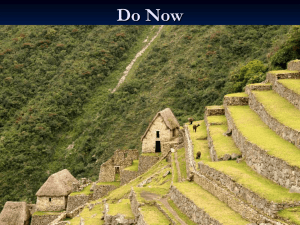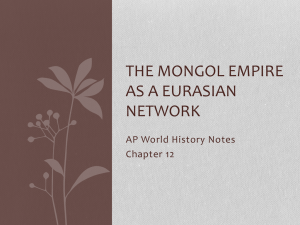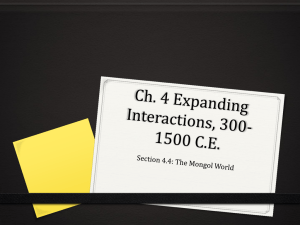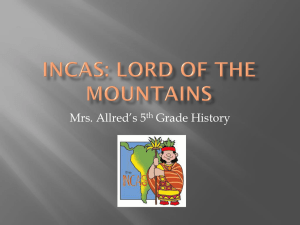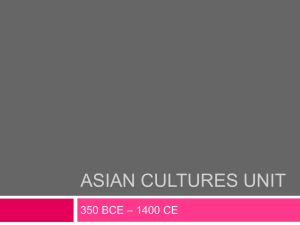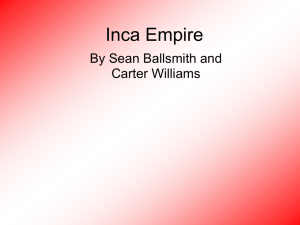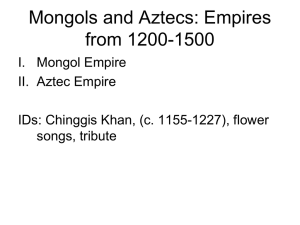Due Friday 11/30
advertisement
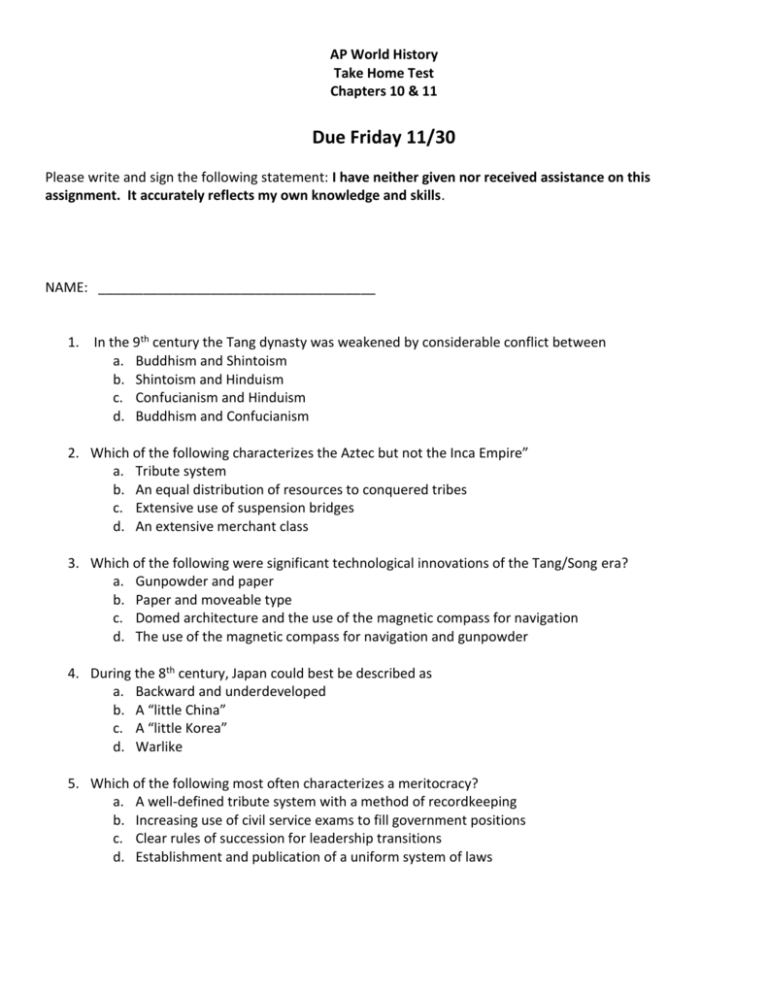
AP World History Take Home Test Chapters 10 & 11 Due Friday 11/30 Please write and sign the following statement: I have neither given nor received assistance on this assignment. It accurately reflects my own knowledge and skills. NAME: _____________________________________ 1. In the 9th century the Tang dynasty was weakened by considerable conflict between a. Buddhism and Shintoism b. Shintoism and Hinduism c. Confucianism and Hinduism d. Buddhism and Confucianism 2. Which of the following characterizes the Aztec but not the Inca Empire” a. Tribute system b. An equal distribution of resources to conquered tribes c. Extensive use of suspension bridges d. An extensive merchant class 3. Which of the following were significant technological innovations of the Tang/Song era? a. Gunpowder and paper b. Paper and moveable type c. Domed architecture and the use of the magnetic compass for navigation d. The use of the magnetic compass for navigation and gunpowder 4. During the 8th century, Japan could best be described as a. Backward and underdeveloped b. A “little China” c. A “little Korea” d. Warlike 5. Which of the following most often characterizes a meritocracy? a. A well-defined tribute system with a method of recordkeeping b. Increasing use of civil service exams to fill government positions c. Clear rules of succession for leadership transitions d. Establishment and publication of a uniform system of laws 6. Which civilization split political leadership between ceremonial and real policy making powers in the era before and after 1000 C.E.? a. China b. Korea c. India d. Japan 7. The establishment of the Mongol Empire had all of the following consequences EXCEPT: a. The reopening and extension of the Silk Road b. The strengthening of maritime trade in the South China Sea c. The diffusion of gunpowder technology d. The increase in the demand for European products such as wool, porcelain, sugar, spices, and coffee. 8. Which of the following civilizations had a capital city that was the largest in the world during the PostClassical era? a. Tang China b. France c. Japan d. Egypt 9. Samurai were to feudal Japan as _______________ were to feudal Europe. a. Knights b. Serfs c. Lords d. Bishops 10. What did Mongols do when they encountered other religions? a. They forced conversion to steppe shamanism b. They adopted all religions into a unique syncretic blend c. They encouraged tolerance and occasionally converted d. They persecuted monotheists but allowed polytheists 11. The Incan ayllu is similar to the Aztec calpulli in that a. Both were the basic organizing units of rural society b. Both were the main religious tenet of the empires’ faith c. Bother were mnemonic devices use to keep government records d. Both were domesticated animals used for meat and wool. 12. Why were the llamas and alpacas so important to the Inca? a. They served as useful pack animals in the high Andes b. They provided wool for Inca textiles c. Their dung could be used for fuel d. All of the above are true 13. Inca roads proved a powerful empire-building tool because a. They allowed Incan religious tradition to be easily spread in the empire through an active missionary movement b. They allowed the Inca government to communicate easily with all parts of the empire and to send troops rapidly to problem spots in the empire c. They allowed the merchant classes to travel quickly with goods to markets throughout the Andes d. They made it possible for Inca mummies to be displayed throughout the empire and therefore to inspire belief in the supremacy of the Inca ruler 14. Which of the following was NOT a part of Chinese culture adopted by the Japanese? a. Centralized government b. A system of writing c. the Bushido d. Buddhist theology 15. The strongest basis of the Mayan economy was a. Crafts and manufacturing b. Agriculture which produced maize, beans, and cocoa c. The silver trade d. Fishing and hunting. 16. Japanese feudalism resulted in part because of a. The emperor’s ability to rule effectively b. The failure of the Heian to govern efficiently c. The overthrow of the shogun after 1200 ce d. The decline of the samurai class 17. To what extent did Confucian values influence the treatment of women in China? a. It was responsible for the practice of concubinage in the imperial residence b. The teachings of Kong Fuxi promoted the practice of female infanticide c. Its view of proper relationships necessarily made women subservient to men. d. It forced women to remain at home with no involvement in the marketplace. 18. Which of the following was the most important factor in the Mongol defeat of the Chinese? a. The development of siege weapons b. Terrorist tactics and mass executions c. Canny leadership and diplomacy d. Nomadic warrior traditions. 19. What was the driving force for urbanization in the Tang and Song dynasties? a. The Chinese economy became dependent on foreign trade and that brought artisans to primary cities b. There were labor shortages in urban areas that drew workers from the overpopulated countryside c. Availability of food from commercial agriculture and a fine distribution system allowed urban growth d. Chinese artisans chose to move into cities for the opportunity to pursue their craft 20. Which of the following statements best sums up the similarities between Song China and dar al-Islam at the end of the first millennium (1000 C.E.)? a. A centralized administration, large cities, and a scholarly tradition b. Xenophobia and a weak military but a thriving economy c. A cosmopolitan outlook, a thriving economy, and population growth d. A solid agricultural base, thriving foreign trade, and dependence on domestic innovation 21. A significant consequence of the Mongol invasions was that a. Northern China was converted into steppe land for Mongol nomads b. Western Europe took over 200 years to fully recover from the Mongol invasions c. Trade and communication along the Silk Road flourished d. Mongol rule in India helped to incorporate the areas into the Indian Ocean trade network 22. In which of the following regions was Kublai Khan a successful conqueror? a. India b. Burma c. China d. Japan 23. Which two groups of people had no indigenous tradition of writing? a. South Americans and West Africans b. Mesoamericans and South Americans c. Mesoamericans and North Africans d. South Americans and Mongols 24. The purpose of the Grand Canal was a. Facilitate trade and communication within China b. Enhance China’s ability to protect itself from foreign invasion c. Bring students into the capital to take the imperial examination d. Irrigate rice paddies in northern China 25. Chinampas allowed for a. Year round agriculture b. An area to dump waste products c. Increased housing for a growing population d. Religious centers to be supplied with food 26. Which of the following statements best characterizes the beliefs of Neo-Confucianists? a. The Mandate of Heaven favors the Song emperors b. This life on earth is unimportant compared to the afterlife c. Humans are essentially good and reasonable d. Familial responsibilities should always come before military duties 27. The combination of loneliness, free time, and writing encouraged Japanese women to a. Produce an outpouring of poetry, diaries, and novels b. Get married c. Form alliances with each other d. Become wandering nuns

